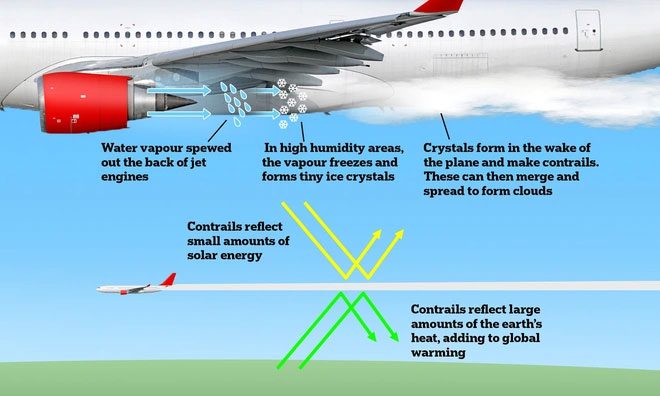The white streaks left by aircraft during flight could triple the world’s global warming by 2050.
The aviation industry has long faced criticism for its negative environmental impacts, particularly due to carbon emissions that exacerbate global warming.
However, few people realize that the white streaks in the sky, a “byproduct” of aircraft, are the most serious contributors to negative atmospheric effects, according to Science.
These white streaks are simply the result of water vapor condensation. During flight, aircraft engines release water vapor into the cold air, causing the vapor to condense. This phenomenon is similar to seeing your breath on a cold day.

White streaks left by aircraft during flight. (Photo: Getty Images).
However, unlike low-level clouds that have a cooling effect, the clouds formed from these white streaks contribute to climate change. This impact is expected to worsen as flight traffic continues to increase. Some estimates suggest that by 2050, global air traffic will quadruple.
Science cites a 2011 study indicating that these white streaks contribute more to global warming than the total carbon emissions produced by aircraft.
To explore how these white streaks might affect the climate in the future, atmospheric physicist Ulrike Burkhardt and her colleagues developed a new atmospheric model.
Specifically, the research team created a model of the atmospheric layer formed by white streaks, completely separating it from naturally occurring clouds.
The goal of the experiment was to model the specific impacts of human-made clouds on everything from their formation to how they interact with the rest of the atmosphere.

The condensation process of water vapor by aircraft creating white streaks during flight. (Photo: Daily Mail).
The data was based on clouds formed from white streaks during flights in 2006. Burkhardt’s team used these figures to predict future air traffic and emissions, thus creating a model of the effects of white streak clouds for 2050. As a result, global warming is projected to be three times higher in 2050 compared to 2006.
Bernd Karcher, a physicist and co-author of the 2011 study, stated that this report is one of the first models to provide detailed predictions on how these special clouds will affect the climate in the future. He also emphasized that distinguishing between natural clouds and those formed from emissions is a breakthrough in modeling predicted global warming.
The researchers also tested a scenario of reducing soot emissions from aircraft by 50% by 2050. The results were promising, showing a 15% reduction in warming effects from clouds formed by white streaks.
However, Burkhardt added that even a scenario of reducing 90% of emissions from cleaner fuel sources would not bring the climate impact of clouds back to 2006 levels. Another proposed solution is to reroute flights. However, such rerouting could force aircraft to burn more fuel and emit more carbon.

Just 2% of flights below 610m could reduce climate impact by up to 59%. (Photo: Getty Images).
Marc Stettler, a researcher from Imperial College London, also agrees with this hypothesis. He suggests that rerouting 2% of flights below 610 meters could reduce climate impact by up to 59%.
“This method is the quickest way the aviation industry can implement to address the impact of aircraft on the climate. Unlike CO2, which persists in the environment for a long time, white streaks only cause harm for a short time after they appear,” Stettler said.


















































